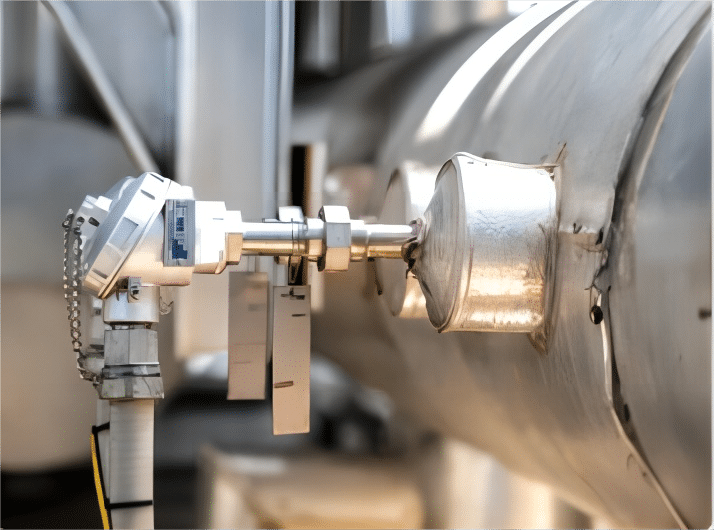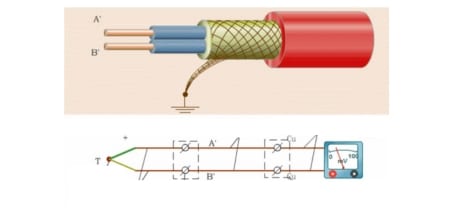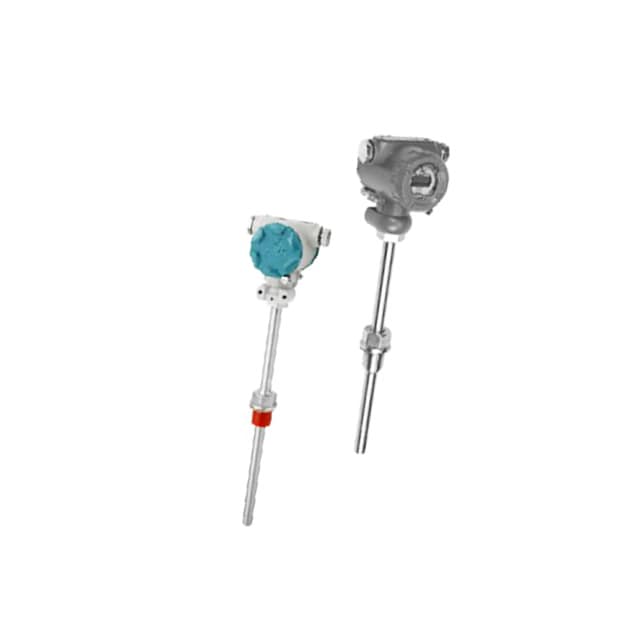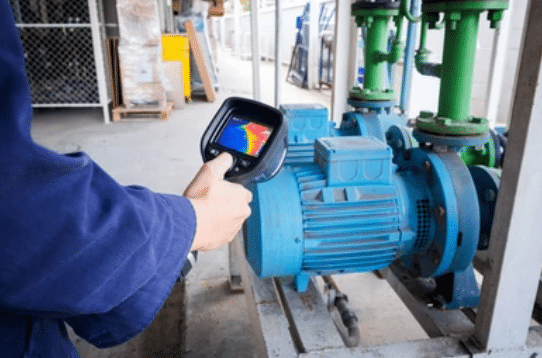Temperature, as a basic and critical environmental parameter, is the temperature range within which many chemical reactions and biological processes are optimized, and even the performance of some electronic circuits is controlled by temperature. Therefore, the measurement of temperature plays a pivotal role in experimentation and engineering, and a variety of methods have been developed for its detection. Overall, temperature measurement and monitoring are key aspects of scientific research and engineering applications.
What is a temperature sensor?
A temperature sensor is a temperature measuring device. It converts heat (temperature) into a readable form such as an electrical signal such as current, voltage or resistance.

Temperature Sensor Applications
- Industrial
- Medical field
- Environmental monitoring
- Electronic equipment
- Food and beverage industry
- Pharmaceutical industry
How do temperature sensors work?
Temperature sensors take temperature readings by means of an electrical signal. They contain two metals that produce a change in voltage or resistance when the temperature changes. Temperature sensor work is based on measuring the voltage across the terminals of a diode. As the voltage increases, the temperature increases accordingly, at which point there is a decrease in voltage between the terminals and emitter of the transistor.
Temperature Sensor Types
- Contact Temperature Sensors
- Non-Contact Temperature Sensors
Contact Temperature Sensors
A contact temperature sensor is a sensor that must be in direct contact with the object to be measured in order to measure its temperature. Contact temperature sensors utilize different physical properties (e.g., resistance, voltage, current, etc.) for temperature measurement, and their changes can reflect the temperature of the object to be measured.
Thermocouples
Thermocouple temperature sensors are most commonly used in industrial, automotive, and everyday household applications. Because they are self-powered, they do not require excitation, have fast response times, and can operate over the widest temperature ranges (-328 to 3182 °F/-200 °C to 1750 °C). A thermocouple is a ring of two different metal wires wound together to produce a voltage change between the two metals that is proportional to the temperature change.
Thermocouples are made from a number of different materials, allowing temperature sensors to measure different temperature ranges and sensitivities. The most commonly used thermocouple sensor is the K-type, and all other thermocouples are also designated using the letters (J, R, and T).

Thermistors
A thermistor, similar to an RTD, is a resistor whose resistance changes with temperature. They are usually made of a polymer or ceramic covered with a glass surface, which is why they are cheaper and less accurate than RTDs. There are two main types of thermistors: positive temperature coefficient (PTC) and negative temperature coefficient (NTC).
Negative temperature coefficient (NTC) thermistors are the most common type and are characterized by a decrease in resistance as the temperature increases. This is because at higher temperatures, the number of carriers (electrons and holes) in the semiconductor material increases, which lowers the resistance. Glass-encapsulated thermistors have an operating range of -72.4 to 482 °F (-50 to 250 °C), and standard thermistors have an operating range as high as 302 °F (150 °C).
Apure PCT Thermocouple Temperature Transmitters with RTDs and thermocouples are field-installed temperature transformer units with a two-wire method with non-linear correction circuitry for direct measurement in industrial processes.

Resistance Temperature Detectors (RTD)
A Resistance Temperature Detector (RTD) is a temperature sensor that operates on the principle of measuring temperature by utilizing the property of resistance to change with temperature. The resistance of a metallic conductor is proportional to its absolute temperature over a given temperature range. The corresponding temperature can be determined by measuring the resistance.RTDs are usually made of pure metals, especially platinum, which has very good stability and linearity over a large temperature range.
RTD Configuration:
- Two-wire: Used when lead lengths are short enough that resistance does not affect accuracy.
- Three-wire: This configuration adds an RTD probe to carry the excitation current, thus providing a way to eliminate line resistance.
- Four-wire: This wire eliminates line resistance by combining separate force and sense leads. This is the most accurate configuration.
Advantages and Disadvantages of RTD
| Advantages | Disadvantages |
| High precision | Low sensitivity |
| Linear output | Higher price |
| Long-term stability | Higher requirements for current sources |
Semiconductor Sensors (IC)
Semiconductor-based temperature sensors are usually integrated into integrated circuits (ICs). Two identical diodes with temperature-sensitive voltages monitor temperature changes. IC sensors have a linear response, but they have the lowest temperature sensor accuracy. This is because ICs have the slowest response over a narrow temperature range (- -70 °C to 150 °C).
There are two types of IC:
Local Temperature Sensors: measure temperature using the physical properties of transistors. They can use analog or digital outputs.
Remote digital temperature sensors: measure the temperature of an external transistor. The transistor is located away from the sensor chip.
Thermostat
A thermostat is a device that automatically adjusts the temperature, usually based on readings from temperature sensors (such as thermocouples, thermistors, or temperature-sensitive capacitors) that measure the temperature of the environment. When the measured temperature exceeds or falls below a set point, the thermostat activates or shuts down heating or cooling equipment to maintain the desired temperature.
There are many types of thermostats available, including knob-type, digital, programmable, and smart thermostats to meet the needs of different users.
Thermometers
Bimetallic thermometer is a mechanical device for measuring temperature that takes advantage of the fact that two different metals have different coefficients of thermal expansion. When the temperature changes, the two metals in the bimetal expand or contract at different rates. Since the two metals are tightly bound together, this difference causes the entire bimetal to bend. In thermometers, this bimetal is usually made into a spiral or curved shape. As the temperature changes, the degree of bimetal bending changes, and this change can be read directly as a change in temperature.

Non-Contact Temperature Sensors
Non-contact temperature sensors are used to measure the temperature of an object without direct contact with the target surface. They rely on the thermal energy radiated by the object to measure temperature, the most common type being infrared (IR) temperature sensors.
Infrared temperature sensors: These sensors measure the intensity of infrared radiation emitted by a target object to determine its temperature. They are ideal for use when an object is moving or the temperature is too high or too low, as they do not need to come into contact with the object itself.
Thermal imaging cameras: Thermal imaging cameras are also infrared sensors that measure and produce a two-dimensional image of the temperature distribution on the surface of an object.
Non-contact temperature sensors are used in a wide variety of industrial and scientific applications, including temperature control of electronic devices, monitoring of chemical reactions, food quality control, and medical diagnostics.

How to choose a temperature sensor?
- Measuring range: Different temperature sensors have different measuring ranges. First determine the temperature range that needs to be measured, and select a sensor that can meet this range.
- Accuracy: Accuracy is another important selection factor for temperature sensors. Different sensor types have different accuracies. Typically, RTDs and thermistors have higher accuracies, while thermocouples have lower accuracies.
- Environment: Temperature sensors are affected by their operating environment, such as humidity, corrosive substances, high pressure and other environmental conditions.
- Application: Application scenarios require a fast response to temperature changes, so it is important to choose a sensor with a fast response time.
- Valve stem (sheath): Thermocouples and RTDs are supplied with 316 stainless steel rods and internal wiring coated with powdered ceramic. Screw head styles are available in two stem types: spring-loaded and welded. The spring-loaded stem is mounted to the bottom of the thermocouple sleeve for maximum thermal sensitivity. Welded stems are ideal for liquid applications.
How to maintain the temperature sensor?
- Periodic Sensor Cleaning
- Periodic calibration
- Check electrical connections
- Avoid extreme environments
- Record and analyze data
Summary
Temperature sensors are widely used in various fields. Selecting and maintaining the right sensor is crucial to ensure the accuracy of measurement and system stability. By understanding the characteristics of different types of sensors and application scenarios, you can better meet the actual needs.
Which temperature sensor to use depends on your application and industry, if you have any questions about temperature sensors or need temperature transmitter, feel free to contact Apure professional and technical team to provide a solution. We also offer instruments for water quality analysis, flow meters, level measurement, pressure measurement, ozone generators and temperature controller.
Extended reading:
Dissolved Oxygen Probe How It Works?
Surface Water vs Groundwater
What Is Municipal Water?
Types of level measurement transmitters
